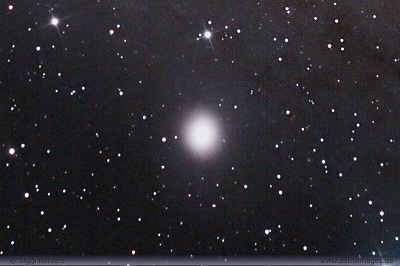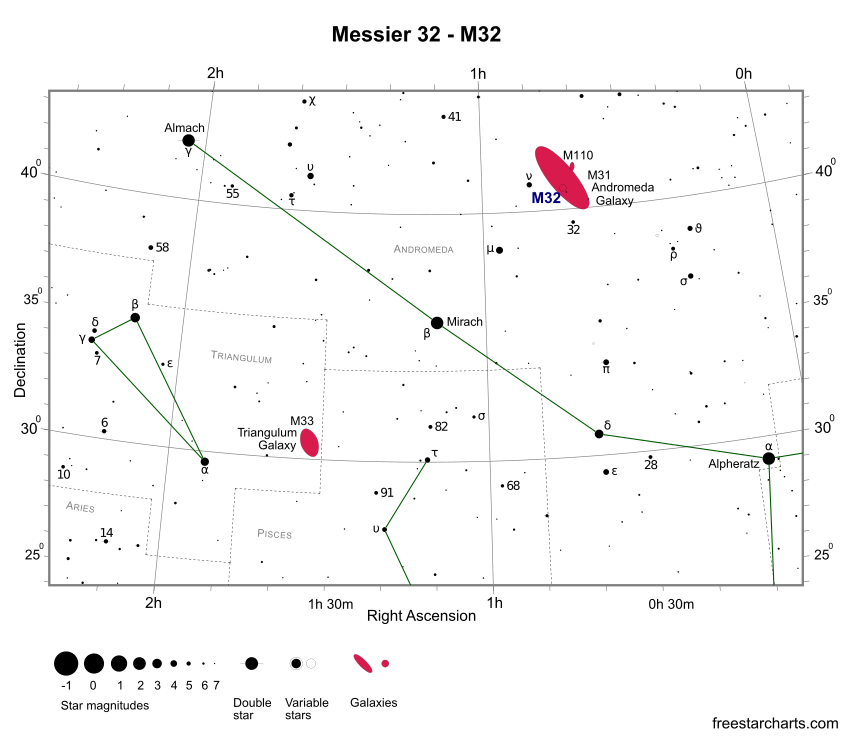M32 is a dwarf elliptical galaxy located in the constellation of Andromeda. It's a satellite of the famous and much larger Andromeda Galaxy (M31) and was the first elliptical galaxy ever observed. M32 was discovered by French astronomer Guillaume Joseph Hyacinthe Jean-Baptiste Le Gentil de la Galaisière (usually referred to as Guillaume Le Gentil) on October 29, 1749. Le Gentil, who was born in Coutances, Normandy, also discovered the Lagoon Nebula (M8) and was the first to catalogue the dark nebula Le Gentil 3 in Cygnus. He also independently found M36 and M38, objects that were discovered by Giovanni Batista Hodierna, around 100 years previously.
At a distance of about 2.65 million light-years, M32 is 110,000 light-years further from us than M31. Like most elliptical galaxies it contains mostly old red and yellow stars with practically no dust or gas, implying no current star formation. However, it has shown hints of star formation in the relatively recent past.
Locating M32 is as easy as locating the Andromeda Galaxy, which is positioned northeast of the Great Square of Pegasus. Of the four stars of the square, only three of them actually belong to Pegasus. The northeastern star and brightest of the four, Alpheratz (α And - mag. +2.1) is part of neighbouring Andromeda. Located 7 degrees northeast of Alpheratz is δ And (mag. +3.3) and a further 8 degrees northeast is Mirach (β And - mag. +2.1). The Andromeda galaxy is 8 degrees northwest of Mirach, at the end of a line connecting Mirach with μ And and ν And. M32 is located 22 arc minutes south of the central region of M31 and appears to be superimposed on a spiral arm.
The galaxy is best seen from Northern Hemisphere latitudes during the months of October, November and December.


Finder Chart for M32 - pdf format (credit:- freestarcharts)
Despite been small (M32 measures only 8.5 x 6.5 arc minutes) it's relatively bright at mag. +8.1 and hence visible in binoculars, appearing non stellar like an out of focus star. The galaxy is an easy target for small telescopes. When viewed through an 80mm (3.1-inch) refractor, it appears as a small round diffuse ball with a distinctly bright central core. The galaxy is brighter and more oval shaped when seen through a larger 200mm (8-inch) scope. However for M32, that's about as good as it gets. Even the biggest amateur scopes don't bring out much more detail and like M110, the other Messier dwarf satellite of M31, it's dwarfed in size when compared to its parent.
Intrinsically, M32 has a diameter of 6,550 by 5,000 light-years and measures about 3 billion solar masses. It's the prototype for the relatively rare class of galaxies known as compact ellipticals. This galaxy may have been originally a spiral galaxy, but at some time in the past had its arms ripped off by the massive tidal forces from M31. As a result, and due to its unusual nature, Halton Arp included it as Number 168 in his Catalogue of Peculiar Galaxies.
M32 Data Table
| Messier | 32 |
|---|---|
| NGC | 221 |
| Object Type | Dwarf elliptical galaxy |
| Classification | cE2 |
| Constellation | Andromeda |
| Distance (light-years) | 2.65 Million |
| Apparent Mag. | +8.1 |
| RA (J2000) | 00h 42m 42s |
| DEC (J2000) | +40d 51m 52s |
| Apparent Size (arc mins) | 8.5 x 6.5 |
| Radius (light-years) | 3,275 x 2,500 |
| Notable Feature | Satellite galaxy of M31 |
| Other Name | Arp 168 |